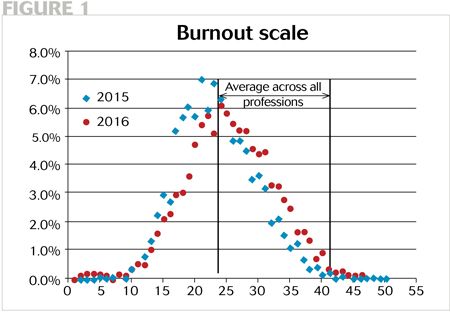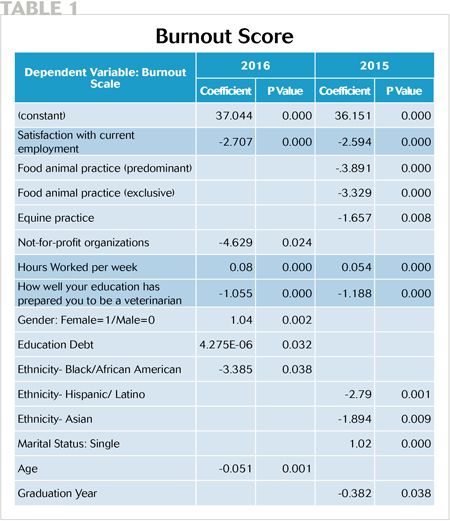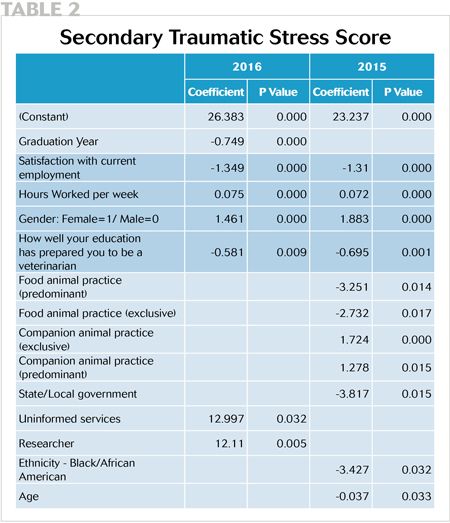Chipping away of the soul: New data on compassion fatigueand compassion satisfactionin veterinary medicine
AVMA economists offer hope and a call for action.

"Wellness" isn't just a buzzword-it's been a major concern for veterinarians in the last several years. The high rate of suicides among veterinarians compared with other professions is reason alone for us to act. So in 2014, at the request of participants in the American Veterinary Medical Association (AVMA) Future Leaders program, the AVMA's Veterinary Economics Division included professional quality of life (ProQol) questions into its annual survey to begin to understand what contributes to wellness-including compassion fatigue and compassion satisfaction.
Wait a minute … "compassion satisfaction"? That might be a new one for you, but the idea is simple. We define it as the level of pleasure you derive from your work. The feeling of pleasure from helping others, the positivity toward colleagues contributing to the work setting, even the greater good of society through your work-all this falls under the umbrella of compassion satisfaction.
Chances are you're familiar with compassion fatigue. It encompasses negative feelings derived from work. In this survey, we've identified it by scoring factors related to burnout (exhaustion, frustration, anger, depression) and secondary traumatic stress (work-related trauma). The ProQol tool is a measure of both.
Measuring compassion fatigue
Based on responses to validated ProQoL questions1 by thousands of individuals across a number of occupations, scores have been established to describe low, normal and high compassion satisfaction and fatigue as well as burnout and secondary trauma.
Data collected in 2015 and 2016 from a random sample of veterinarians indicate that the mean ProQoL scores for compassion fatigue, burnout and secondary trauma are in the lower normal range for veterinarians, while compassion satisfaction was in the higher normal range.
However, these mean scores fail to illustrate the number of respondents who were in the high range for burnout and secondary trauma. To address this issue, each dot on the charts in Figure 1 and Figure 2 represents the percentage of respondents who received that specific score. A score higher than 35 on the burnout or secondary trauma stress scale suggests a need to seek help to deal with the factors that are causing burnout, secondary trauma stress, or both.


Top three causes of compassion fatigue
While the scores provide a warning for individuals about their relative level of compassion fatigue, they do not indicate the likely source of the fatigue. Some possible sources of burnout and secondary traumatic stress may be found in demographic and other factors. Using the demographic and other factors supplied with the survey, we found several to be statistically significant in their association with burnout and secondary trauma stress.


Three factors were statistically significant in both years and for both sources of compassion fatigue.
> Satisfaction with current employment (on a scale of 1 to 5)
> Hours worked per week
> Educational preparedness for performing veterinary services
The less satisfied veterinarians were with their current employment, the more hours they worked and the less prepared they were for the job, the greater their level of compassion fatigue. With secondary traumatic stress, women were significantly more likely to be stressed than men; they were more likely to experience burnout in 2016 only.
Numerous other factors were found to be significantly associated with one of the components of compassion fatigue in at least one of the survey years. Food animal, equine and state and local government practitioners were less likely to suffer from compassion fatigue, while companion animal practitioners were more likely. Nonwhite ethnicities (e.g. African American, Hispanic, Asian) were less likely to suffer high compassion fatigue scores, as were older veterinarians.
Many experts associate high levels of student debt with compassion fatigue. But at first glance, student debt and veterinary compensation appear to have little relationship with either burnout or secondary traumatic stress. However, because there may be a relationship between levels of debt or compensation to gender or satisfaction with current employment, these factors may not have been able to express their independent effect on the compassion fatigue variables.
We have previously noted that there is a very strong relationship between employment satisfaction and the level of employment compensation, with few high-income earners indicating a low level of employment satisfaction while a high number of low-income earners indicate considerable employment dissatisfaction.
Chipping away of the soul-and what to do about it
In a recent webinar on the financial constraints that influence pet healthcare decisions, Barry Kipperman, DVM, DACVIM, indicated that pet owner healthcare decisions may be a source of compassion fatigue for veterinarian.2 In the same vein, I (Michael Dicks) wrote in an article earlier this year that "every decision to weigh tangible benefits above intangibles in deciding the fate of animals (human or otherwise) has caused a small incessant chipping away of the soul. A reason to discount hope. A deep cumulative reason."
Our research suggests that this small incessant chipping away of the soul-compassion fatigue-is affected by hours worked, level of educational preparedness for the job, and satisfaction with current employment.
All of these are, in some way, related to workplace culture. They're not necessarily a tragedy of economic decisions in and of themselves, but rather how the workplace culture responds to the needs of veterinarians involved in these decisions. The AVMA looks forward to more extensive research to develop strategies to reduce or eliminate both the need for economic decisions by pet owners and the adverse effect of these decisions on the well-being of veterinarians.
FDA approves oral drug for broad canine protection against parasites
October 7th 2024Elanco's lotilaner, moxidectin, praziquantel, and pyrantel chewable tablets (Credelio Quattro) provide a single monthly dose for protection against fleas, ticks, heartworms, roundworms, hookworms, and 3 species of tapeworm.
Read More
dvm360 announces winners of the Veterinary Heroes program
Published: September 6th 2024 | Updated: November 5th 2024This year’s event is supported by corporate sponsor Schwarzman Animal Medical Center and category sponsors Blue Buffalo Natural, MedVet, Banfield Pet Hospital, Thrive Pet Healthcare and PRN Pharmacal.
Read More